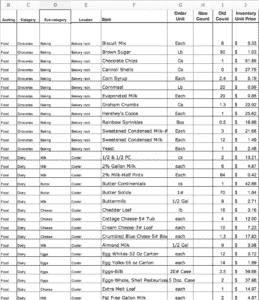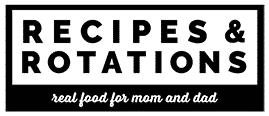 Ask anyone who is responsible for a professional foodservice operation what keeps them up at night, and be prepared to hear a pretty long list of concerns. In one category will be things like providing guests with enough variety, being on top of making seasonal menu changes, serving hot food hot and cold food cold, perfect seasoning and mastery of basic cooking techniques. Another category of concerns includes keeping food costs on budget, not running out of anything, reducing waste, stocking products with the correct specs and keeping an organized and spotless kitchen. One of the best and most important tools for tackling all the items in the second category – and helping with concerns in the first category, too – is taking a monthly inventory of all the products in your kitchen. Monthly inventories are absolutely the norm in any free-standing or hotel restaurant, whether big or small, corporate or mom & pop. Monthly, or ever weekly, inventories are also a given in any corporate, hospital, prison or educational foodservice operation. As far as I’ve seen, it’s only in senior living that, for some reason, inventories are frequently not part of the standard operating procedure. Let’s take a look at just how inventories work, and how they can help your operation in many concrete ways.
Ask anyone who is responsible for a professional foodservice operation what keeps them up at night, and be prepared to hear a pretty long list of concerns. In one category will be things like providing guests with enough variety, being on top of making seasonal menu changes, serving hot food hot and cold food cold, perfect seasoning and mastery of basic cooking techniques. Another category of concerns includes keeping food costs on budget, not running out of anything, reducing waste, stocking products with the correct specs and keeping an organized and spotless kitchen. One of the best and most important tools for tackling all the items in the second category – and helping with concerns in the first category, too – is taking a monthly inventory of all the products in your kitchen. Monthly inventories are absolutely the norm in any free-standing or hotel restaurant, whether big or small, corporate or mom & pop. Monthly, or ever weekly, inventories are also a given in any corporate, hospital, prison or educational foodservice operation. As far as I’ve seen, it’s only in senior living that, for some reason, inventories are frequently not part of the standard operating procedure. Let’s take a look at just how inventories work, and how they can help your operation in many concrete ways.
First, let’s consider the concept of “food cost.” For most of us, this is the monthly, budgeted amount that we can spend on food. If we spend less, we pat ourselves on the back. If we go over, we hear about it. The key point here is to realize that the amount of money we spend on food invoices in any given month does not tell us how much money we’ve spent on the food we used that month. This is where doing a monthly inventory comes in.
How to calculate your monthly food cost using food inventories
Here’s how it works:
- Take an “opening” inventory of all the food, and its value, that you have in house. Do this at the end of the last day of the month preceding the first month you plan to track.
- At the end of the first month you’re tracking, add the value of the opening inventory to the cost of any food purchased during that month. (Exclude any non-food items on your invoices, like cleaning supplies.)
- Do a “closing” inventory at the end of the last day of the first month you’re tracking and subtract its value from the sum of the opening inventory and purchases for that month.
- This will tell you your cost for the products that were actually used that month, not what was purchased. There’s a difference.
- Continue to take an inventory on the last day of every month and perform the same calculations.
To summarize:
Opening Inventory + Food Purchased – Closing Inventory = Food Costs
If you’ve never done inventories before, this can sound like an awful lot of busy work. I promise, after you and your staff do it a couple of times, it gets much easier, faster and efficient. Writing a spreadsheet containing all of your items, along with columns for amounts and values will help a lot. If you give the task of writing that spreadsheet some thought and effort**, it will pay off every month.
You can organize it by category (Dairy, Canned Goods, Produce, Frozen Meats, etc.), and even put it together so that the items are in the same order that you’ll encounter them as you go around your kitchen doing the inventory. You can modify it every month to make it easier and more efficient to use. Some people like to do their inventories on an iPad, others like to print out the pages and put them on a clip board. Do whatever makes the most sense for your operation.
Try dividing up the work so that one or two people (wearing coats) inventory the walk-ins, another does the dry storage, another does the reach-ins, and so on. If you’ve got the staff, using the buddy system can help it go faster.
Benefits of performing monthly inventories to accurately track your monthly food cost
If you have any doubts about whether it’s worth doing inventories to see what food is used in a month, and not what food is purchased, consider this one example. Let’s say your chef decides to take advantage of a great deal on frozen shrimp and buys three months’ worth. If you didn’t do an inventory and just went by what you paid in invoices that month, it would look like your food expenses went through the roof that month, instead of reflecting what, in time, would be an actual savings. Not only would you have an incorrect idea of your actual costs, but you wouldn’t be doing your chef’s morale much good, either. It would be a similar situation if you happened to get a big delivery on the last day of a month.
Another big benefit of taking a regular inventory is that your staff will have no option but to really get to know exactly what’s in the kitchen, where it is, what condition it’s in, and how much of it there is. Make the most of the time that inventory is taking place by encouraging your staff to clean, organize and rotate stock as needed, as they go. It could also be the perfect time to clean up an area, big or small, that may have been neglected. With a little encouragement, your staff will also take more ownership and care in receiving, stocking and rotating deliveries if they know they’re going to have to deal with it all anyway at the next inventory.
An obvious and important advantage to doing inventories is that it will absolutely make your ordering more accurate and proficient. Not really being certain of what you’ve already got in house will either result in ordering too much of something and increasing the chance of it going bad and being thrown out, or not ordering enough and either running out at service or having to make an emergency run and pay retail for it. Having product delivered with the wrong specs (random chicken breasts instead of 5-ounce portions, 80% lean ground beef instead of 90%…), and then accepting it, will raise your costs and lower the quality and consistency of the food you serve. If you make sure that your order guide matches your inventory list, everyone will get to know what should be delivered, notice if something is wrong, and correct it before it goes into your stock and then gets prepped and served. In any case, having better control over your ordering and receiving process will improve your food cost, your prep time, and the quality and consistency of the food you serve. It will also lower the stress levels throughout your operation!
Seeing just what you have on hand is also very helpful when it comes to developing specials. If you suddenly become aware of a couple of pounds of something in your freezer, or a half of a case of a certain vegetable that will spoil in a couple of days, see if you, or one of your cooks, can come up with a soup, appetizer, or even a nice garnish for the next day. You’ll get to be creative, give your guests something new, and use up product that would have probably gone into the trash because no one noticed it was even there.
There are a lot of good reasons for monthly inventories to be part of your kitchen operation. The hardest part might be getting over the inertia that’s preventing you from taking the first step. The sooner you start, the sooner you’ll be reaping the benefits.
